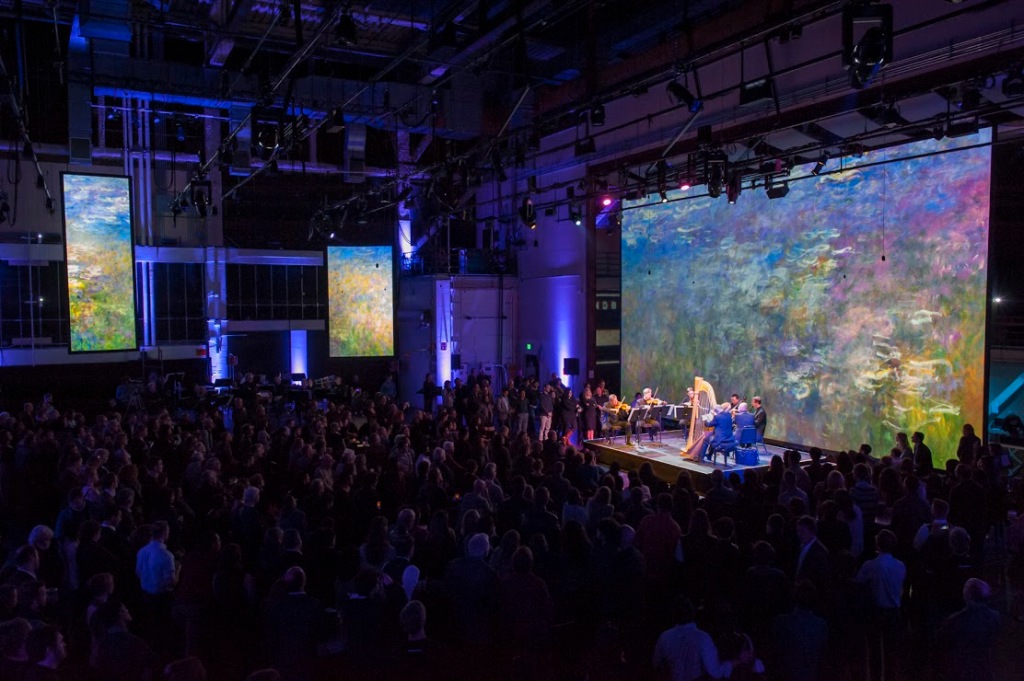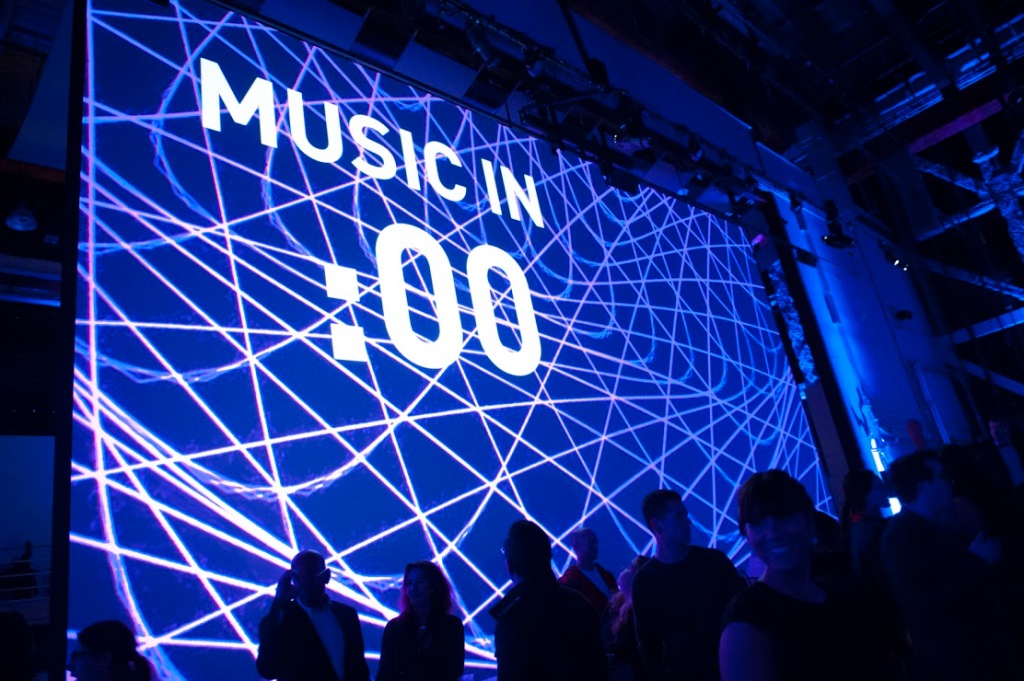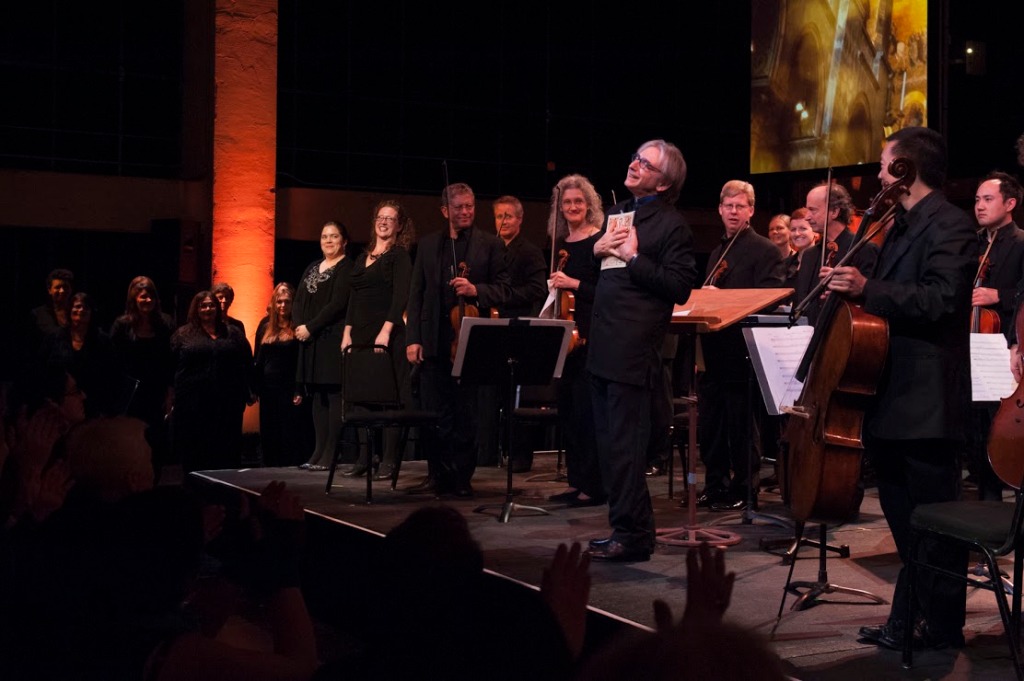SoundBox—SF Symphony’s new space for musical experimentation

The atmosphere Saturday night at the opening of SoundBox, San Francisco’s Symphony’s new experimental space for music. Ravel’s “Introduction and Allegro” performed by Alexander Barantschik, Dan Carlson, Jonathan Vinocour, Amos Young, Tim Day, Carey Bell, Doug Rioth. Video projections by Adam Larsen. Photo: courtesy SFS
Christmas started early for ARThound when a dear friend invited me to Saturday night’s unveiling of SoundBox, MTT’s (Michael Tilson Thomas’) and San Francisco Symphony’s (SFS) newest venture. SoundBox was designed to fill a gap in Bay Area music scene by providing an experimental space where anything musical can happen and to engage a younger, hipper audience with SFS and serious music. Judging from Saturday’s thrilling reception which enthralled its sellout crowd of 450, Soundbox will do all that and more. It also seems poised to give our brilliant but nerdy MTT some street swagger, the kind of coolness cred that he’s been aching for while collecting all those Grammies for classical recordings. If you haven’t heard, SoundBox is a huge refurbished music space at 300 Franklin Street (in San Francisco). Formerly known as Zellerbach A, it was one of SFS’s most dour on-site rehearsal spaces, ironically renowned for its dead sound.
With generous patron funding and the board’s desire to revision SFS’ audience outreach, the cavernous space was entirely revamped. Berkeley’s Meyer Sound was engaged to install its patented multi-speaker “Constellation” system, transforming the space into a virtual sound lab. Now, with the push of touchscreen button, the venue can seamlessly tweak its acoustics (reverberation and decay times) for various pieces in a performance allowing otherworldly sounds to emerge from its tremendously talented SFS musicians and choral members. Add state-of-the-art video projection capacity, making for an incredible visual experience, sleek quilted leather ottoman and low tables (even the furnishings will be tweaked with each performance), a fully-stocked bar serving thematic cocktails and innovative cuisine—wella! SoundBox has the grit of an European art house, the verve of a sophisticated nightclub, the acoustics of a world class concert hall, and, as if it needs to be said, the world’s best musicians playing tunes exquisitely curated by MTT.

Combining the excitement of an art happening with the verve of a sophisticated nightclub, the acoustics of a world class concert hall, and adventurous music spanning ten centuries, Saturday night’s opening of SoundBox will be long remembered. Photo: courtesy SFS.
On Saturday, 7:45PM, the crowd was already lining up on Franklin Street. The buzz: no one knew exactly what to expect but we were all excited by the program we’d read about online and the promise of road-testing something completely new. The pre-concert hour was dedicated to John Cage, who believed that every sound can be music, and featured a musical feast of his “Branches,” featuring electronically amplified giant cacti, and “Inlets” which coaxed sounds from shells filled with water that gurgled when moved and from amplified burning pinecones. As people entered the darkened foyer of Soundbox and were confronted with Cage’s music, they passed by a curious gallery space, specially curated by MTT, that included beautifully lit minimalist arrays of live cacti, a table of sea shells in a pool of water and colorful huge multi-layered projections of cacti. Wow…felt like entering one of those East European art happenings I’d covered in the 1980’s. Once we passed through a closed black door, we entered the spacious main hall, which offered a hip but relaxed atmosphere—two low wooden platforms served stages and lots of low leather seating that could be easily re-arranged. People were free to amble about and get a drink or just settle in and get busy with their phones and texting.
The inaugural run, called “Extremities,” kicked off dramatically with “Stella splendens in monte,” a brief anonymous Spanish work (local composer Mason Bates contributed the percussion arrangements.) The SFS chorus, in flowing robes, entered from the back of the hall, and made a dramatic procession to the stage, their lyrical voices swelling to fill every corner of the space. As they passed by each of us, we got a sampling of each singer’s individual voice. From there, it only got better—a very well-thought sonic and visual feast was about to unfold and we were ravenous for it. The audience snapped their fingers, clapped, yowled and tossed their exquisite locks…and the musicians beamed with pride. A glowing MTT looked like he’d dropped a decade as he engaged with the audience in a very heartfelt way, talking about musical choices and the potential of the space.

Steve Reich’s “Music for Pieces of Wood,” performed by members of the SF Symphony
Percussion Section at SoundBox. From L to R: Tom Hemphill (from Sonoma County), James Lee Wyatt III, Victor Avdienko, Jacob Nissly, Raymond Froehlich. Photo: courtesy SFS
Highpoints for ARThound: Steve Reich’s minimalist “Music for Pieces of Wood” featured five SFS percussionists with tuned hardwood claves creating a pulsing bed of rhythmically complex continuous sound. This reminded me of the miraculous frog concerto I am treated to in my pond in Sonoma County every time a serious storm blows through. After 8 minutes of this mesmerizing sound, which was accompanied by projections of Adam Larsen’s images of a New York skyline, we were all in trance mode. When it ended, and everyone stopped playing, we were left with a very perceptible silence, a void in the acoustic atmosphere that left us all profoundly aware of the power of sound to inflate and deflate the psyche.
Ravel’s exquisite “Introduction and Allegro” (1905) shimmered and glowed when played by a small ensemble of seven SFS musicians including principal harpist Douglas Rioth and concertmaster Sasha Barantschik whose beloved 1742 Guarnerius del Gesù (“The David”) cast a spell over the audience, some of whom swept away tears. The chamber piece showcased the space’s ability to tease out nuances in the contrasting sonorities. The velvety woodwinds, the percussive harp and the warm resonance of the strings were all so clear, so distinct, that I felt I was getting a personal introduction to the possibilities of these instruments.
One of the evening’s hip visuals was the Nordic visual art pioneer, Steina’s (Steina Vasulka’s), seven minute video, “Voice Windows” (1986), featuring the voice of Joan La Barbara. The short engrossing film was co-presented by SFS and SFMOMA and points to the limitless possibilities for future collaboration in a space like this. Since the early 1970’s, Steina, in collaboration with Woody Vasulka, has explored intricate transformations of vision, space and sound, through digital technologies, mechanical devices and natural landscape. “Voice Windows” was an exquisite and haunting example of her artistry in manipulating digital and camera-generated images and layering that with “real” and altered sound.

Beaming MTT (Michael Tilson Thomas) conducts members of the SF Symphony and Chorus in Monteverdi’s “Magnificat” (1610) from “Vespro della Beata Vergine.” Photo: courtesy SFS
After two intermissions, the evening closed with Monteverdi’s glorious “Magnificat” (1610) from Vespro della Beata Vergine. It is one of the eight most ancient Christian hymns and is taken directly from the Gospel of Luke where the Virgin Mary visits her cousin Elizabeth who is pregnant with the future John the Baptist. When Elizabeth praises Mary for her faith, Mary sings the “Magnificat” in response. Talk about immersive—the 19 minute piece featured soloists, the chorus and orchestra, all in rapturous splendor with gorgeous golden-hued projections of a Venetian church enhancing the mood.
Details: The next Sound Box performance, “Curiosities,” is January 9 and 10th, 2015. Doors open at 8 PM and performance starts at 9 PM. Tickets on sale now: $25 for open seating. The space accommodates 450 and will sell out quickly. The SoundBox website is not working correctly. Call the SFS Box office (415) 864-6000 to purchase tickets. SoundBox is located at 300 Franklin Street, San Francisco, CA. Parking: (is hell) Performing Arts Garage (360 Grove Street) or Civic Center Garage (between Polk, Larkin, Grove and McAllister).
December 15, 2014 - Posted by genevaanderson | Art, Chamber Music, Classical Music, Jazz Music, SFMOMA, Symphony | "Extremities", 1742 Guarneriusdel Gesù, Adam Larsen, Constellation sound system, Douglas Rioth, experimental music, John Cage, Magnificat, Mason Bates, Meyer Sound, Michael Tilson Thomas, Monteverdi Magnificat, MTT, Music for Pieces of Wood, music happening, Ravel, Ravel Introduction and Allegro, San Francisco Symphony, Sasha Barantschik, SFMOMA, SFS Chorus, SoundBox, Steina, Steina Vasulka, Steina Voice Windows, Steve Reich, The David, Vespro della Beata Vergine
No comments yet.
Pages
Categories
- Art (181)
- Asian Art Museum (19)
- Berkeley Art Museum (2)
- California Academy of Sciences (1)
- de Young Museum (22)
- Legion of Honor (18)
- Oakland Museum of California (10)
- Petaluma Arts Council (9)
- SFMOMA (23)
- Sonoma County Museum (5)
- Book (5)
- Chamber Music (14)
- Classical Music (51)
- Dance (19)
- Film (208)
- Food (69)
- Gardening (11)
- Green Music Center (23)
- Jazz Music (8)
- Opera (93)
- Photography (3)
- Symphony (23)
- television (1)
- Theater (2)
- Theatre (91)
- Uncategorized (6)
- Wine (10)
- Art (181)
Recent Comments
- Karen Petersen on SFO’s “Dialogues of the Carmelites”―an opera of faith, with inspiring conversations sung to beautiful music―through Sunday, October 30
- Review: San Francisco Opera’s “Hansel and Gretel”—happily ever after, with adult moments « ARThound on Meet Richard Savino, whose baroque instruments add period splendor to Handel’s “Orlando,” at SF Opera through June 27
- Karen Petersen on Meet Drogen, the unflappable equine star of SF Opera’s “Carmen”—he’s from Penngrove and is a rare Gyspy Vanner
- linda anderson on Meet Richard Savino, whose baroque instruments add period splendor to Handel’s “Orlando,” at SF Opera through June 27
- Zoe Tennant on Meet Richard Savino, whose baroque instruments add period splendor to Handel’s “Orlando,” at SF Opera through June 27
December 2014 M T W T F S S 1 2 3 4 5 6 7 8 9 10 11 12 13 14 15 16 17 18 19 20 21 22 23 24 25 26 27 28 29 30 31 Archives
Leave a comment